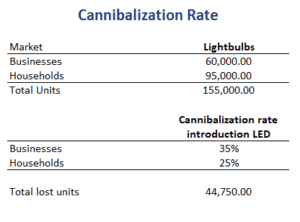Cannibalization rate
The cannibalization rate (CR) measures the percentage of new product sales that will replace existing product sales. This rate is very important when a company plans to introduce new substitutes or new products. Both when introducing substitutes or new products, the existing sales may go down because customers buy the new product. The cannibalization factor is an example of how technological development has an impact on demand. An example of cannibalization is the introduction of lamps with LED technology. This caused the sale of traditional light bulbs to go down almost completely.
On this page, we discuss the cannibalization rate formula as well as a numerical example that illustrates how to use the formula. The Excel spreadsheet used can be downloaded at the bottom of the page.
Cannibalization rate formula
The cannibalization rate formula allows us to estimate the cannibalization rate factor. The formula looks as follows
The CR can differ between different sales channels. In that case, it has to be estimated separately for each sales channel. Also, it is likely to be lower for business customers than for retail customers. In practice, scenario analysis will be used to estimate the CR.
Cannibalization rate example
Let’s have a look at a numerical example. The table below calculates the CR for a company that introduces a new product and looks at business and retail consumers separately.
The Excel spreadsheet can be downloaded at the bottom of the this page.
Summary
We discussed the cannibalization factor. Cannibalization occurs when a company introduces an upgraded version of an existing product or when it introduces a substitute. In both cases, sales of the existing product will go down. The cannibalization factor quantifies the impact of new products on the sales of existing products.
Download the Excel spreadsheet
Want to have an implementation in Excel? Download the Excel file: Cannibalization factor template

